Daily Water Mapping and Spatiotemporal Dynamics Analysis over the Tibetan Plateau
Abstract
1. Introduction
- It provides the a cloud-free daily lake mapping dataset for the TP with demonstrated high accuracy and consistency.
- It introduces an improved methodological framework that integrates multi-source MODIS data and explicitly accounts for snow/ice cover, addressing limitations in prior products.
- It offers new insights into TP lake dynamics over the past 25 years, highlighting both widespread expansion and localized shrinkage, thereby advancing understanding of hydrological and environmental change in high-altitude regions.
| Region | No. | Reference | Temporal Range | Temporal Resolution | Spatial Resolution | Data Source |
|---|---|---|---|---|---|---|
| Tibetan Plateau | 1 | [22] | 1970, 1990, 2000, 2010 | Single-temporal (4 periods) | 1970: 80 m; 1990: 28.5 m | Landsat MSS/ETM+, GeoCover circa 1990/2000 |
| 2 | [14] | 2005–2006 | Single-temporal (1 period) | 2000: 14.25 m; 2010: 30 m | CBERS CCD, Landsat ETM+ | |
| 3 | [23] | 2000–2013 | Monthly (14 years) | 500 m | MODIS (MOD09A1) | |
| 4 | [24] | 1960, 2005, 2014 | Single-temporal (3 periods) | 1960: 1:250,000; 2005: 19.5 m; 2014: 16 m | Historical survey, CBERS CCD, Landsat TM/ETM+/OLI, GF-1 WFV/PMS | |
| 5 | [25] | 2015–2017 | Monthly (3 years) | 40 m | Sentinel-1 SAR | |
| 6 | [4] | 1991–2018 | Yearly (18 years) | 30 m | Landsat TM/ETM+/OLI | |
| China | 7 | [26] | 1960–1980 | Single-temporal (1 period) | 1:250,000 | Historical survey |
| 8 | [27] | 1990–2000 | Single-temporal (2 periods) | 30 m | Landsat TM/ETM+ | |
| 9 | [28] | 2005–2006 | Two-temporal (Wet and dry seasons) | 20–30 m | CBERS CCD, Landsat TM/ETM+ | |
| 10 | [29] | 2005–2008 | Single-temporal (1 period) | 30 m | Landsat TM/ETM+ | |
| Global | 11 | [30] | 2004 | Single-temporal (1 period) | 200 m/1000 m/5000 m/25,000 m | MGLD, LRs, WRD, DCW, ArcWorld, WCMC, GLCC |
| 12 | [31] | 2000–2015 | Yearly (16 years) | 250 m | MODIS (MOD44C) | |
| 13 | [32,33,34] | 1992–2015 | Monthly (24 years) | 25 km | SSMI, ERS | |
| 14 | [35] | 1984–2015 | Monthly (32 years) | 30 m | Landsat TM/ETM+/OLI | |
| 15 | [15,16] | 2003–2022 | Daily (20 years) | 250 m | MODIS (MOD09GQ, MYD09GQ) | |
| 16 | [19] | 2001–2024 | Daily (25 years) | 500 m | MODIS (MOD09GA) | |
| 17 | [36] | 1992–2018 | Monthly/Bimonthly (27 years, excluding frozen seasons) | 30 m | Landsat TM/ETM+/OLI | |
| 18 | [37] | 2000–2018 | 8-day interval (19 years) | 250 m | MODIS (MOD09Q1) |
2. Study Area and Data
2.1. Study Area
2.2. Daily Reflectance Time Series
2.3. Daily Land Surface Temperature Time Series
2.4. Topographic Data
3. Method
- Preprocessing. The daily cloud, cloud shadow and snow/ice are firstly extract for each pixel based on the MOD09GA/MYD09GA and MOD11A1 time series. In addition, the mountainous areas are also extracted.
- Perpixel water mapping. Perpixel water mapping is performed for each MOD09GA/ MYD09GA imagery. The spectral characteristics of water are primarily utilized in this step.
- Superpixel water mapping. Firstly, the segmentation is performed for each MOD09GQ/ MYD09GQ scene to get the superpixel result. Then, for each superpixel, a voting based strategy is applied to decide whether it is water or not.
- Fusion. To improve the reliability of daily water mapping, results derived from MOD09GA+MOD09GQ and MYD09GA+MYD09GQ imagery are fused.
- Time-series processing. Cloud, cloud shadow, and missing pixels are interpolated using temporal information, resulting in a final cloud-free daily water mapping product.
3.1. Preprocessing
3.1.1. Cloud and Cloud Shadow Extraction
3.1.2. Snow/Ice Cover Extraction
3.1.3. Mountainous Area Extraction
3.1.4. Perpixel Water Mapping Based on 500 m MODIS Reflectance Time Series
3.2. Superpixel Water Mapping
3.2.1. Superpixel Generation Based on 250 m MODIS Reflectance Time Series
3.2.2. Voting-Based Strategy for Superpixel Water Mapping
- Water proportion: the fraction of pixels within the superpixel that are classified as “water”.
- Snow/Ice proportion: the fraction of pixels labeled as “Snow/Ice”.
- Cloud proportion: the fraction of pixels labeled as “cloud”.
- Cloud shadow proportion: the fraction of pixels labeled as “cloud shadow”.
- Mountainous area proportion: the fraction of pixels labeled as “mountainous area”.
3.3. Fusion
- When the two datasets give the same classification result, that value is directly adopted.
- When one dataset indicates cloud, cloud shadow, or mountainous area while the other provides a valid classification, we adopt the valid classification result.
- When both datasets provide valid but different classifications, then the distance between sensor and earth is applied, which is recorded as “Range” layer in MOD09GA/MYD09GA dataset. MODIS uses a whiskbroom scanning imaging mode, so imagery acquired at the nadir has the highest spatial resolution and clarity with the minimal range value. In contrast, pixels at the scan edges are captured at higher viewing angles, leading to a larger range value and lower image sharpness, as shown in Figure 8. Therefore, the classification result with the smaller range value is selected as more reliable.
3.4. Time-Series Processing
- When , the pixel is considered as low dynamic, and we set . If no valid data is found within days, annual-aggregation results are used for gap-filling.
- When , the pixel is considered moderately dynamic, and we set . If no valid data is found within days, seasonal-aggregation results are used for gap-filling.
- When , the pixel is considered highly dynamic, and we set . If no valid data is found within days, monthly-aggregation results are used for gap-filling.
4. Results
4.1. Spatial-Temporal Distribution of Water Bodies in Tibetan Plateau
4.2. Validation
4.2.1. Direct-Validation with High-Resolution Water Mapping Result
4.2.2. Cross-Validation with Other Water Mapping Product
4.3. Change Trend for Lakes the Tibetan Plateau
4.4. Change Trend for the 10 Largest Lakes
4.5. Seasonal Variation Characteristics of Water Body Area
5. Discussion
5.1. Influence of Spatial Resolution on the Classification of Snow/Ice and Water
5.2. Driving Factors Behind the Observed Lake Area Changes
6. Conclusions
Author Contributions
Funding
Data Availability Statement
Conflicts of Interest
References
- Zhang, G.; Luo, W.; Chen, W.; Zheng, G. A robust but variable lake expansion on the Tibetan Plateau. Sci. Bull. 2019, 64, 1306–1309. [Google Scholar] [CrossRef] [PubMed]
- Zhang, G.; Yao, T.; Chen, W.; Zheng, G.; Shum, C.; Yang, K.; Piao, S.; Sheng, Y.; Yi, S.; Li, J.; et al. Regional differences of lake evolution across China during 1960s–2015 and its natural and anthropogenic causes. Remote Sens. Environ. 2019, 221, 386–404. [Google Scholar] [CrossRef]
- Zhu, L.; Zhang, G.; Yang, R.; Liu, C.; Yang, K.; Qiao, B.; Han, B. Lake Variations on Tibetan Plateau of Recent 40 Years and Future Changing Tendency. Bull. Chin. Acad. Sci. 2019, 34, 1254–1263. [Google Scholar] [CrossRef]
- Zhao, R.; Fu, P.; Zhou, Y.; Xiao, X.; Grebby, S.; Zhang, G.; Dong, J. Annual 30-m big Lake Maps of the Tibetan Plateau in 1991–2018. Sci. Data 2022, 9, 164. [Google Scholar] [CrossRef]
- Li, Z.; Deng, F.; Gong, J.; Xiang, L.; Han, Y.; Zheng, P.; Zhao, E. Lake dynamics in Tibetan Plateau during 1990–2020 and exploratory factor analyses using Google Earth Engine. Environ. Sci. Pollut. Res. 2023, 30, 41609–41622. [Google Scholar] [CrossRef] [PubMed]
- Mehta, P.; Siebert, S.; Kummu, M.; Deng, Q.; Ali, T.; Marston, L.; Xie, W.; Davis, K.F. Half of twenty-first century global irrigation expansion has been in water-stressed regions. Nat. Water 2024, 2, 254–261. [Google Scholar] [CrossRef]
- Tellman, B.; Sullivan, J.A.; Kuhn, C.; Kettner, A.J.; Doyle, C.S.; Brakenridge, G.R.; Erickson, T.A.; Slayback, D.A. Satellite imaging reveals increased proportion of population exposed to floods. Nature 2021, 596, 80–86. [Google Scholar] [CrossRef] [PubMed]
- Brocca, L.; Zhao, W.; Lu, H. High-resolution observations from space to address new applications in hydrology. Innovation 2023, 4, 100437. [Google Scholar] [CrossRef]
- Xu, F.; Liu, Y.; Zhang, G.; Zhao, P.; Woolway, R.I.; Zhu, Y.; Ju, J.; Zhou, T.; Wang, X.; Chen, W. Recent large-inland-lake outbursts on the Tibetan Plateau: Processes, causes, and mechanisms. Nat. Hazards Earth Syst. Sci. 2025, 25, 1187–1206. [Google Scholar] [CrossRef]
- Cai, Y.; Ke, C.Q.; Li, X.; Zhang, G.; Duan, Z.; Lee, H. Variations of Lake Ice Phenology on the Tibetan Plateau From 2001 to 2017 Based on MODIS Data. J. Geophys. Res. Atmos. 2019, 124, 825–843. [Google Scholar] [CrossRef]
- Chen, Z.; Zhang, P.; Zhang, Y.; Xu, X.; Ji, L.; Tang, H. Thick Cloud Removal in Multi-Temporal Remote Sensing Images via Frequency Spectrum-Modulated Tensor Completion. Remote Sens. 2023, 15, 1230. [Google Scholar] [CrossRef]
- Kaya, Y. Slope-aware and self-adaptive forecasting of water levels: A transparent model for the Great Lakes under climate variability. J. Hydrol. 2025, 662, 133948. [Google Scholar] [CrossRef]
- Zhao, Q.; Ji, L.; Su, Y.; Zhao, Y.; Shi, J. SRSF-GAN: A Super-Resolution-Based Spatial Fusion With GAN for Satellite Images With Different Spatial and Temporal Resolutions. IEEE Trans. Geosci. Remote Sens. 2023, 61, 1–19. [Google Scholar] [CrossRef]
- Wang, W.; Xiao, P.; Feng, X.; Li, Y.; Du, Y.; Jin, Y. Monitoring lake changes of Qinghai–Tibetan Plateau over the past 30 years using satellite remote sensing data. Chin. Sci. Bull. 2014, 8, 701–714. [Google Scholar]
- Klein, I.; Gessner, U.; Dietz, A.J.; Kuenzer, C. Global WaterPack—A 250 m resolution dataset revealing the daily dynamics of global inland water bodies. Remote Sens. Environ. 2017, 198, 345–362. [Google Scholar] [CrossRef]
- Klein, I.; Uereyen, S.; Sogno, P.; Twele, A.; Hirner, A.; Kuenzer, C. Global WaterPack—The development of global surface water over the past 20 years at daily temporal resolution. Sci. Data 2024, 11, 472. [Google Scholar] [CrossRef] [PubMed]
- Klein, I.; Mayr, S.; Gessner, U.; Hirner, A.; Kuenzer, C. Water and hydropower reservoirs: High temporal resolution time series derived from MODIS data to characterize seasonality and variability. Remote Sens. Environ. 2021, 253, 112207. [Google Scholar] [CrossRef]
- Ji, L.; Gong, P. Surface Water. In Comprehensive Remote Sensing, 2nd ed.; Elsevier: Amsterdam, The Netherlands, 2024. [Google Scholar] [CrossRef]
- Ji, L.; Gong, P.; Wang, J.; Shi, J.; Zhu, Z. Construction of the 500-m Resolution Daily Global Surface Water Change Database (2001–2016). Water Resour. Res. 2018, 54, 10270–10292. [Google Scholar] [CrossRef]
- Li, Y.; Zhang, M. Cumulus over the Tibetan Plateau in the Summer Based on CloudSat–CALIPSO Data. J. Clim. 2016, 29, 1219–1230. [Google Scholar] [CrossRef]
- Zhang, S.; Geng, X.; Ji, L.; Tang, H. Hyperspectral image unsupervised classification using improved connection center evolution. Infrared Phys. Technol. 2022, 125, 104241. [Google Scholar] [CrossRef]
- Zhang, G.; Yao, T.; Xie, H.; Kang, S.; Lei, Y. Lakes’ state and abundance across the Tibetan Plateau. Chin. Sci. Bull. 2014, 59, 3010–3021. [Google Scholar] [CrossRef]
- Wang, C.; Feng, M.; Jiang, H.; Zhao, S.; Li, Y. Detection and Analysis of Qinghai-Tibet Plateau Lake Area from 2000 to 2013. J. Geo-Inf. Sci. 2015, 17, 99–107. [Google Scholar]
- Wan, W.; Long, D.; Hong, Y.; Ma, Y.; Yuan, Y.; Xiao, P.; Duan, H.; Han, Z.; Gu, X. A lake data set for the Tibetan Plateau from the 1960s, 2005, and 2014. Sci. Data 2016, 3, 160039. [Google Scholar] [CrossRef]
- Zhang, Y.; Zhang, G.; Zhu, T. Seasonal cycles of lakes on the Tibetan Plateau detected by Sentinel-1 SAR data. Sci. Total Environ. 2020, 703, 135563. [Google Scholar] [CrossRef]
- Wang, S.; Dou, H. Lakes in China; Science Press: Beijing, China, 1989. [Google Scholar]
- Gong, P.; Niu, Z.; Cheng, X.; Zhao, K.; Zhou, D.; Guo, J.; Liang, L.; Wang, X.; Li, D.; Huang, H.; et al. China’s wetland change (1990–2000) determined by remote sensing. Sci. China Earth Sci. 2010, 53, 1036–1042. [Google Scholar] [CrossRef]
- Ma, R.; Yang, G.; Duan, H.; Jia, Y.; Khandelwal, A.; Yao, X.; Li, X.; Feng, X. China’s lakes at present: Number, area and spatial distribution. Sci. China Earth Sci. 2011, 54, 283–289. [Google Scholar] [CrossRef]
- Yang, X.; Lu, X. Drastic change in China’s lakes and reservoirs over the past decades. Sci. Rep. 2014, 4, 6041. [Google Scholar] [CrossRef] [PubMed]
- Lehner, B.; Döll, P. Development and validation of a global database of lakes, reservoirs and wetlands. J. Hydrol. 2004, 296, 1–22. [Google Scholar] [CrossRef]
- Carroll, M.L.; Townshend, J.R.; DiMiceli, C.M.; Noojipady, P.; Sohlberg, R.A. A new global raster water mask at 250 m resolution. Int. J. Digit. Earth 2009, 2, 291–308. [Google Scholar] [CrossRef]
- Prigent, C.; Jimenez, C.; Bousquet, P. Satellite-derived global surface water extent and dynamics over the last 25 years (GIEMS-2). J. Geophys. Res. Atmos. 2020, 125, e2019JD030711. [Google Scholar] [CrossRef]
- Papa, F.; Prigent, C.; Aires, F.; Jimenez, C.; Rossow, W.B.; Matthews, E. Interannual variability of surface water extent at the global scale, 1993–2004. J. Geophys. Res. 2010, 115, D12111. [Google Scholar] [CrossRef]
- Prigent, C.; Papa, F.; Aires, F.; Jimenez, C.; Rossow, W.B.; Matthews, E. Changes in land surface water dynamics since the 1990s and relation to population pressure. Geophys. Res. Lett. 2012, 39, L08403. [Google Scholar] [CrossRef]
- Pekel, J.F.; Cottam, A.; Gorelick, N.; Belward, A.S. High-resolution mapping of global surface water and its long-term changes. Nature 2016, 540, 418–422. [Google Scholar] [CrossRef]
- Yao, F.; Wang, J.; Wang, C.; Crétaux, J.F. Constructing long-term high-frequency time series of global lake and reservoir areas using Landsat imagery. Remote Sens. Environ. 2019, 232, 111210. [Google Scholar] [CrossRef]
- Han, Q.; Niu, Z. Construction of the Long-Term Global Surface Water Extent Dataset Based on Water-NDVI Spatio-Temporal Parameter Set. Remote Sens. 2020, 12, 2675. [Google Scholar] [CrossRef]
- Xu, J.; Grumbine, R.E.; Shrestha, A.; Eriksson, M.; Yang, X.; Wang, Y.; Wilkes, A. The Melting Himalayas: Cascading Effects of Climate Change on Water, Biodiversity, and Livelihoods. Conserv. Biol. 2009, 23, 520–530. [Google Scholar] [CrossRef] [PubMed]
- Tang, H.; Yu, K.; Hagolle, O.; Jiang, K.; Geng, X.; Zhao, Y. A cloud detection method based on a time series of MODIS surface reflectance images. Int. J. Digit. Earth 2013, 6, 157–171. [Google Scholar] [CrossRef]
- Niu, Z.; Gong, P.; Cheng, X.; Guo, J.; Wang, L.; Huang, H.; Shen, S.; Wu, Y.; Wang, X.; Wang, X.; et al. Geographical characteristics of China’s wetlands derived from remotely sensed data. Sci. China Ser. D Earth Sci. 2009, 52, 723–738. [Google Scholar] [CrossRef]
- Che, L.; Li, S.; Liu, X. Improved surface water mapping using satellite remote sensing imagery based on optimization of the Otsu threshold and effective selection of remote-sensing water index. J. Hydrol. 2025, 654, 132771. [Google Scholar] [CrossRef]
- Geng, X.; Tang, H. Clustering by connection center evolution. Pattern Recognit. 2020, 98, 107063. [Google Scholar] [CrossRef]
- Zhang, G.; Bolch, T.; Chen, W.; Crétaux, J.F. Comprehensive estimation of lake volume changes on the Tibetan Plateau during 1976–2019 and basin-wide glacier contribution. Sci. Total Environ. 2021, 772, 145463. [Google Scholar] [CrossRef] [PubMed]
- Huang, D.; Zhang, J.; Liu, J.; Hu, X.; Jin, J. Hydrologic regime dynamics and driving factors of Anglaren Co on the Tibetan Plateau based on multi-source remote sensing data. J. Hydrol. 2025, 661, 133645. [Google Scholar] [CrossRef]
- Qiao, B.; Zhu, L. Differences and cause analysis of changes in lakes of different supply types in the north-western Tibetan Plateau. Hydrol. Processes 2017, 31, 2752–2763. [Google Scholar] [CrossRef]
- Sang, Y.F.; Chen, D.; Gong, T. What Caused the Decline of Water Level of Yamzho Yumco During 1975–2012 in the Southern Tibetan Plateau? J. Geophys. Res. Atmos. 2020, 125, e2019JD031121. [Google Scholar] [CrossRef]
- Yao, J.; Xu, N.; Wang, M.; Liu, T.; Lu, H.; Cao, Y.; Tang, X.; Mo, F.; Chang, H.; Gong, H.; et al. SWOT satellite for global hydrological applications: Accuracy assessment and insights into surface water dynamics. Int. J. Digit. Earth 2025, 18, 2472924. [Google Scholar] [CrossRef]
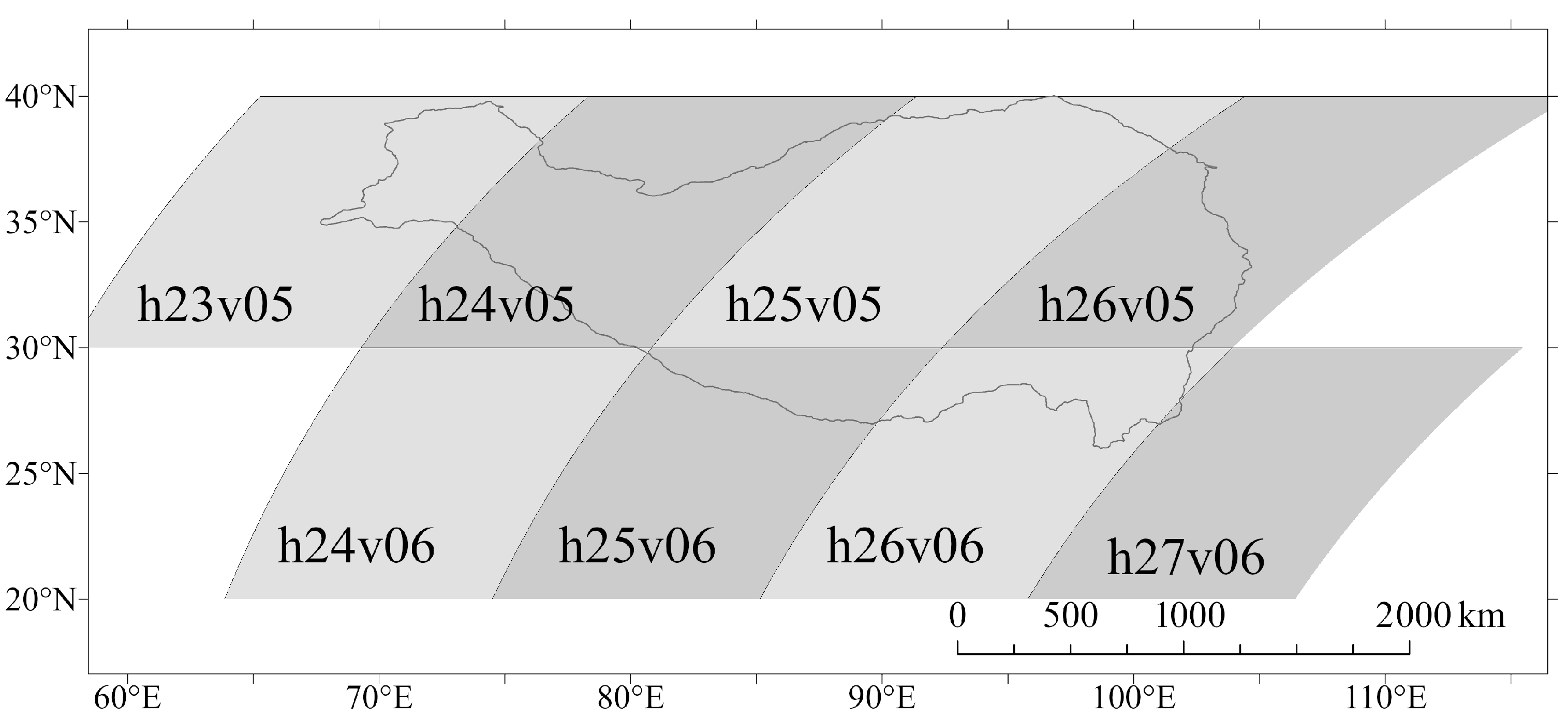
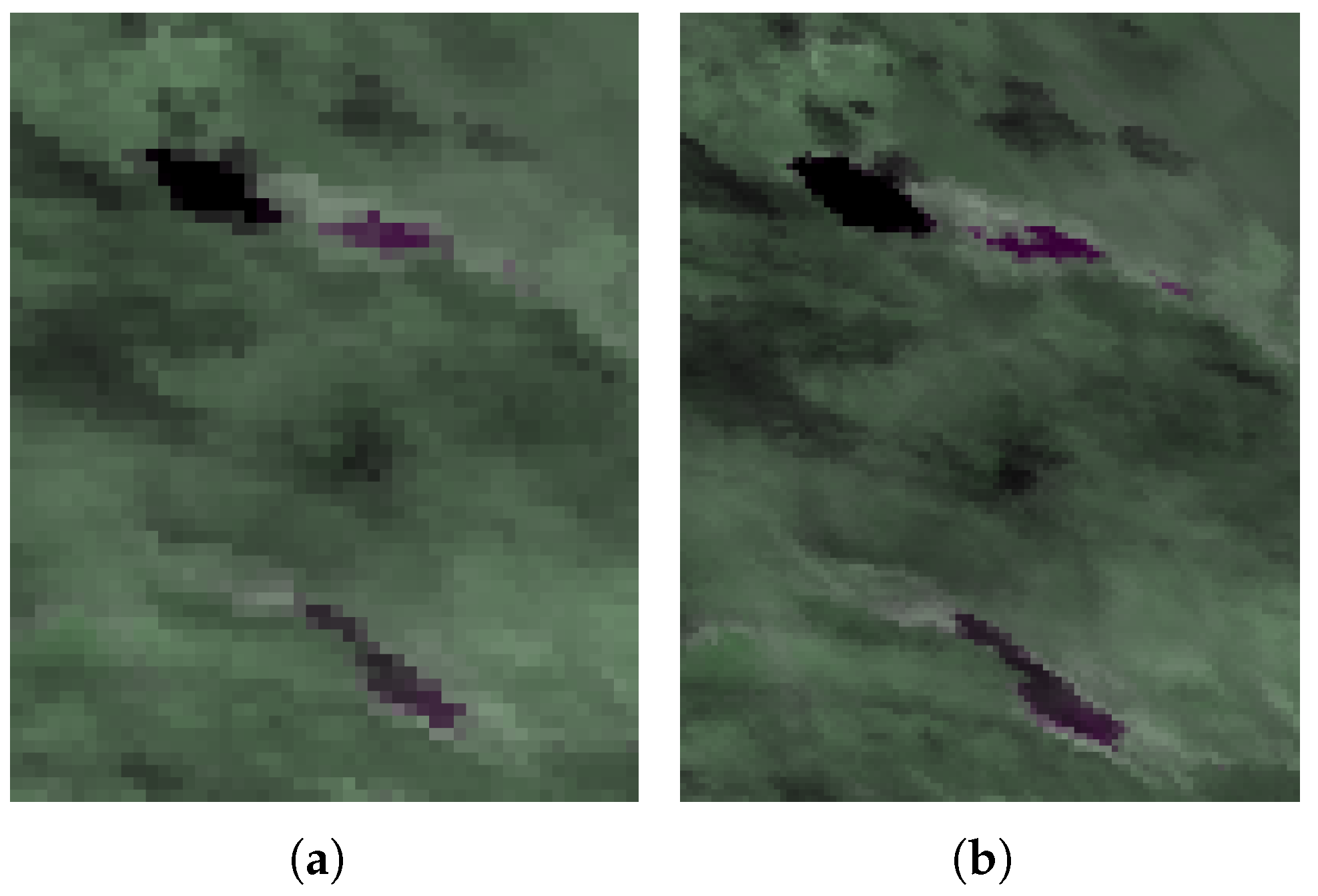

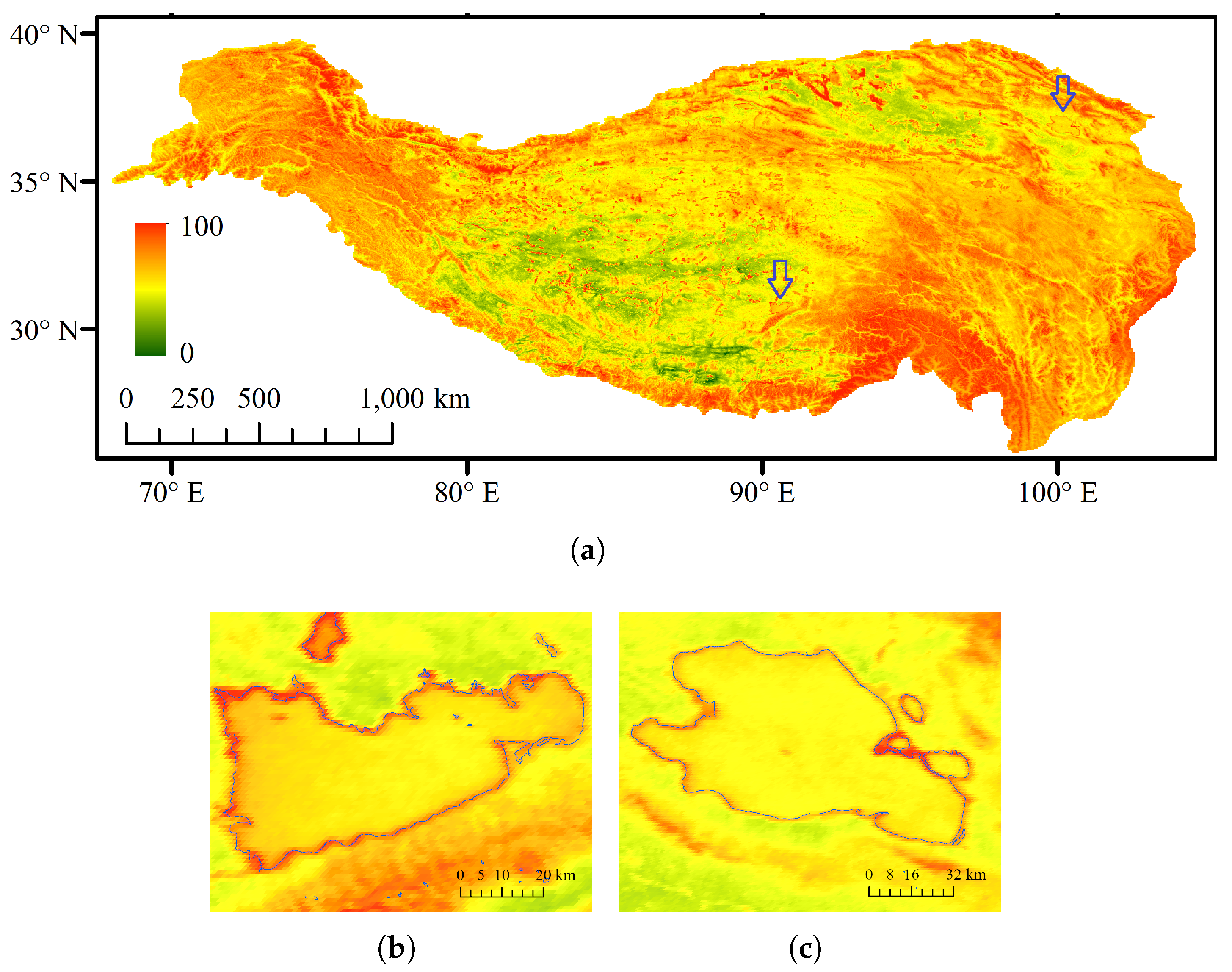
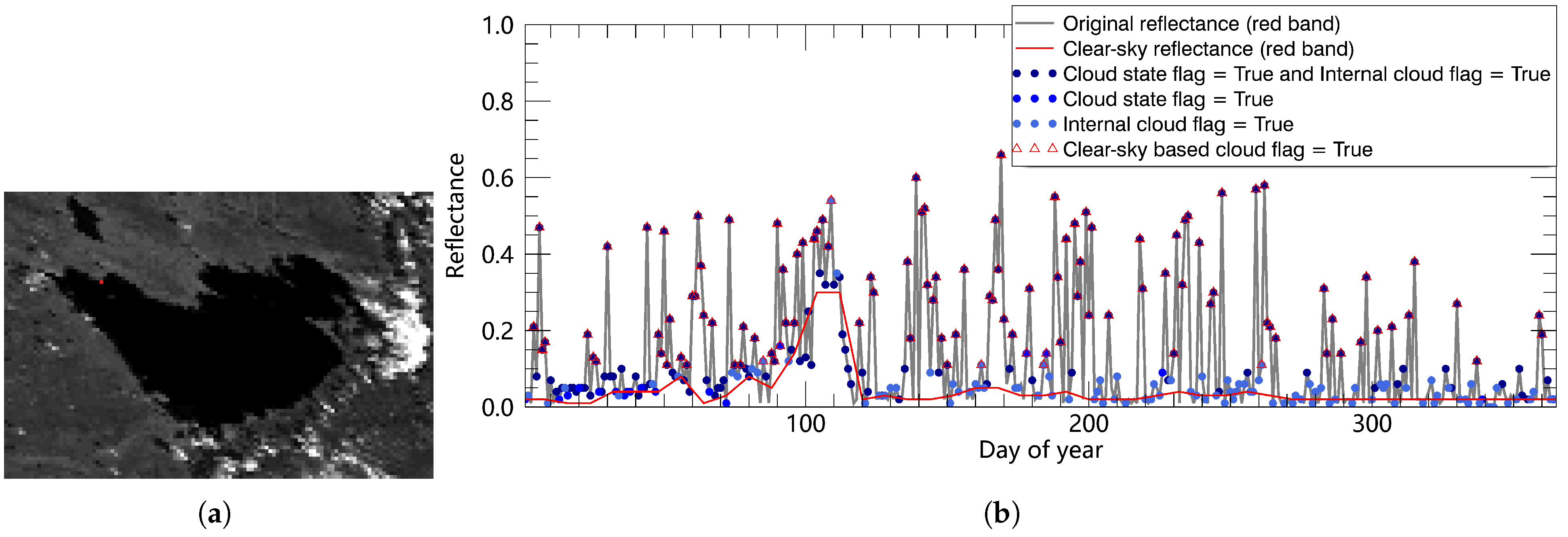





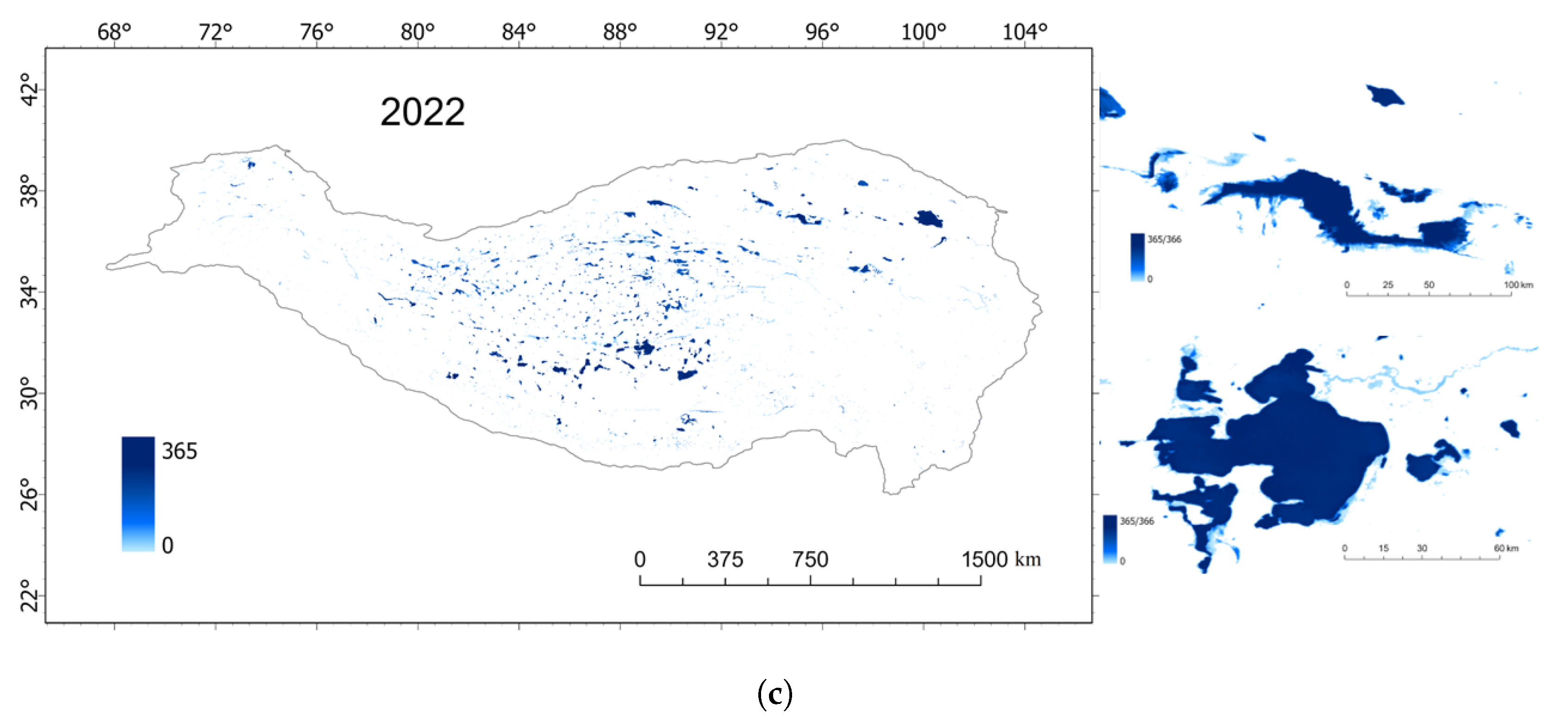
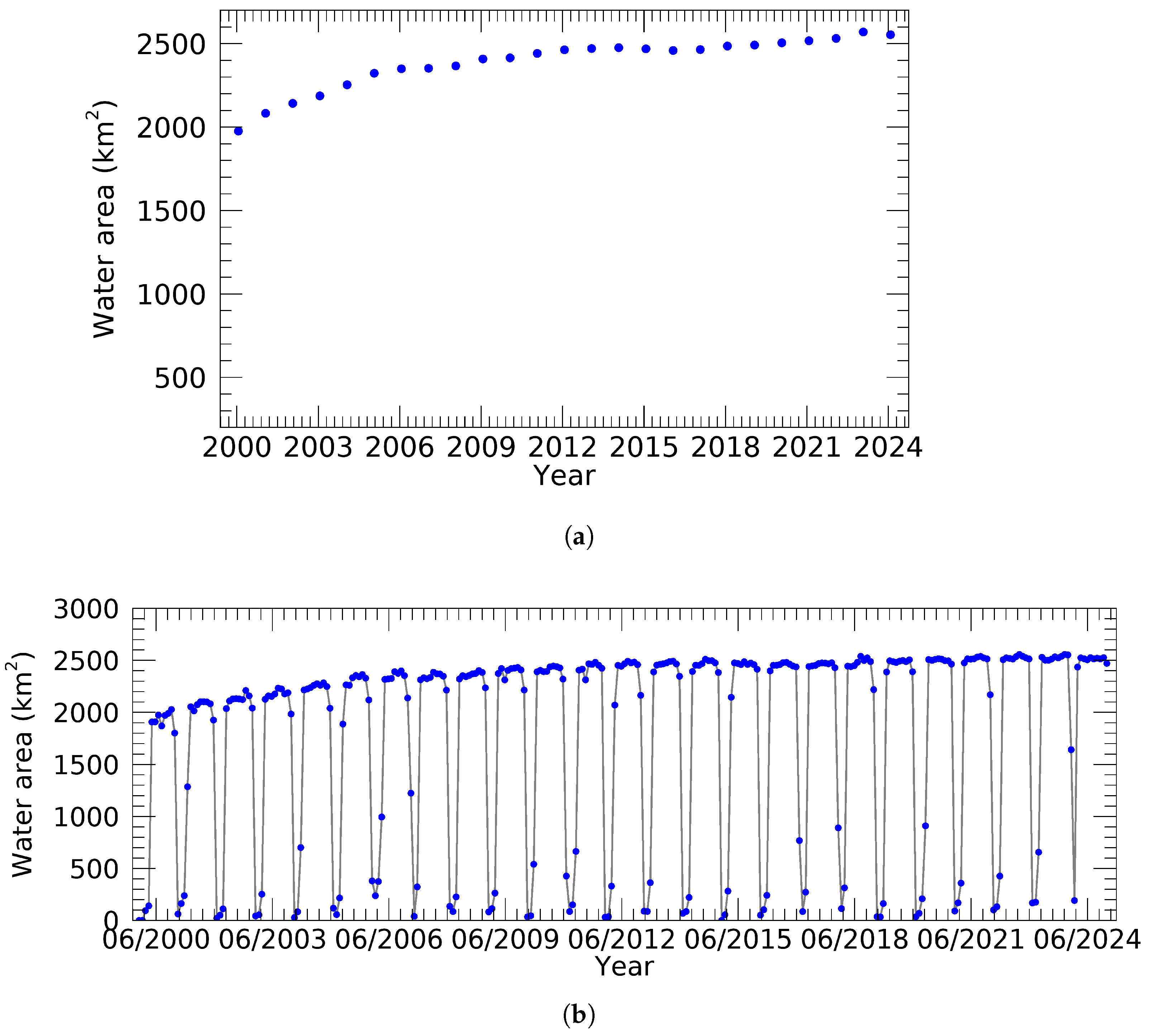

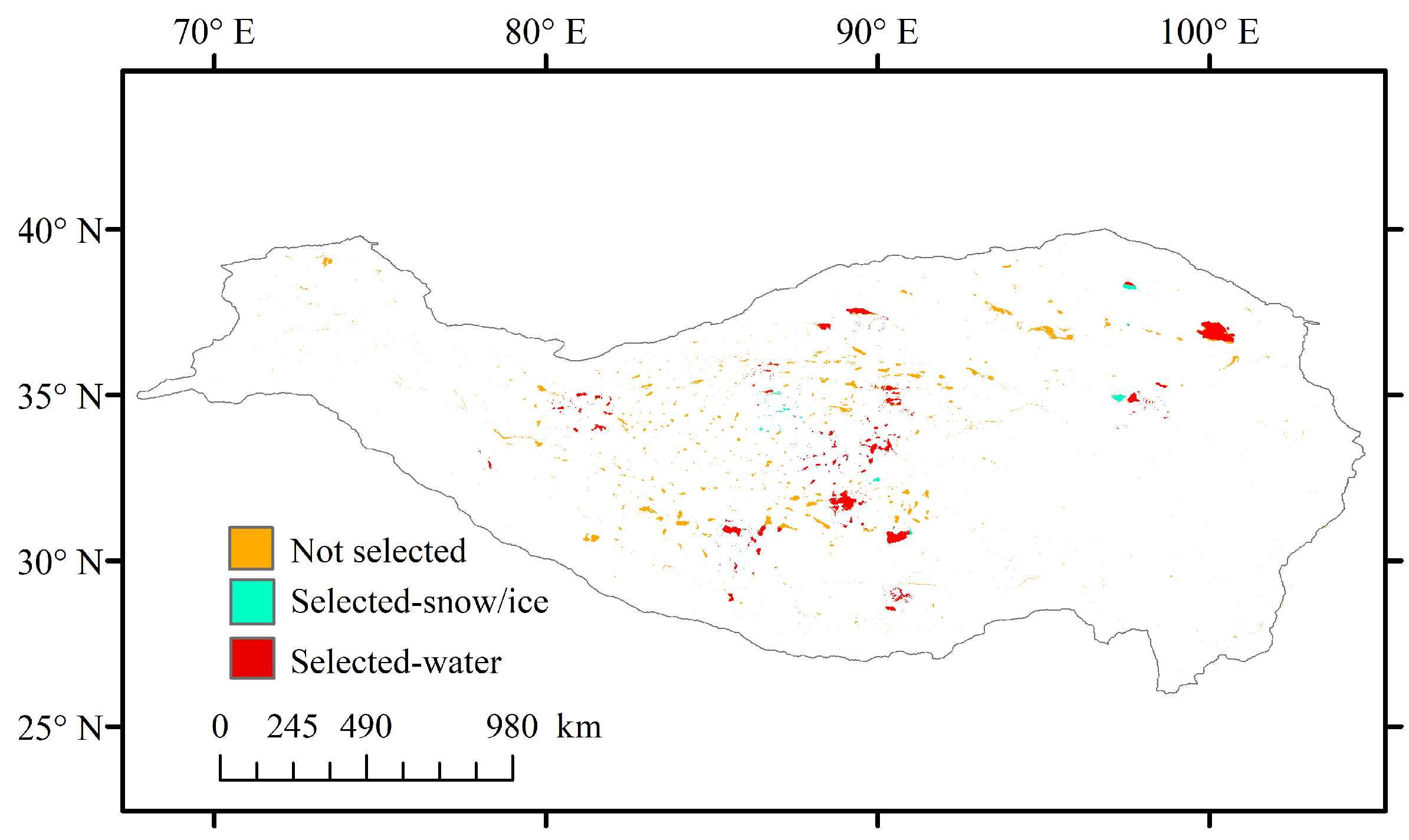

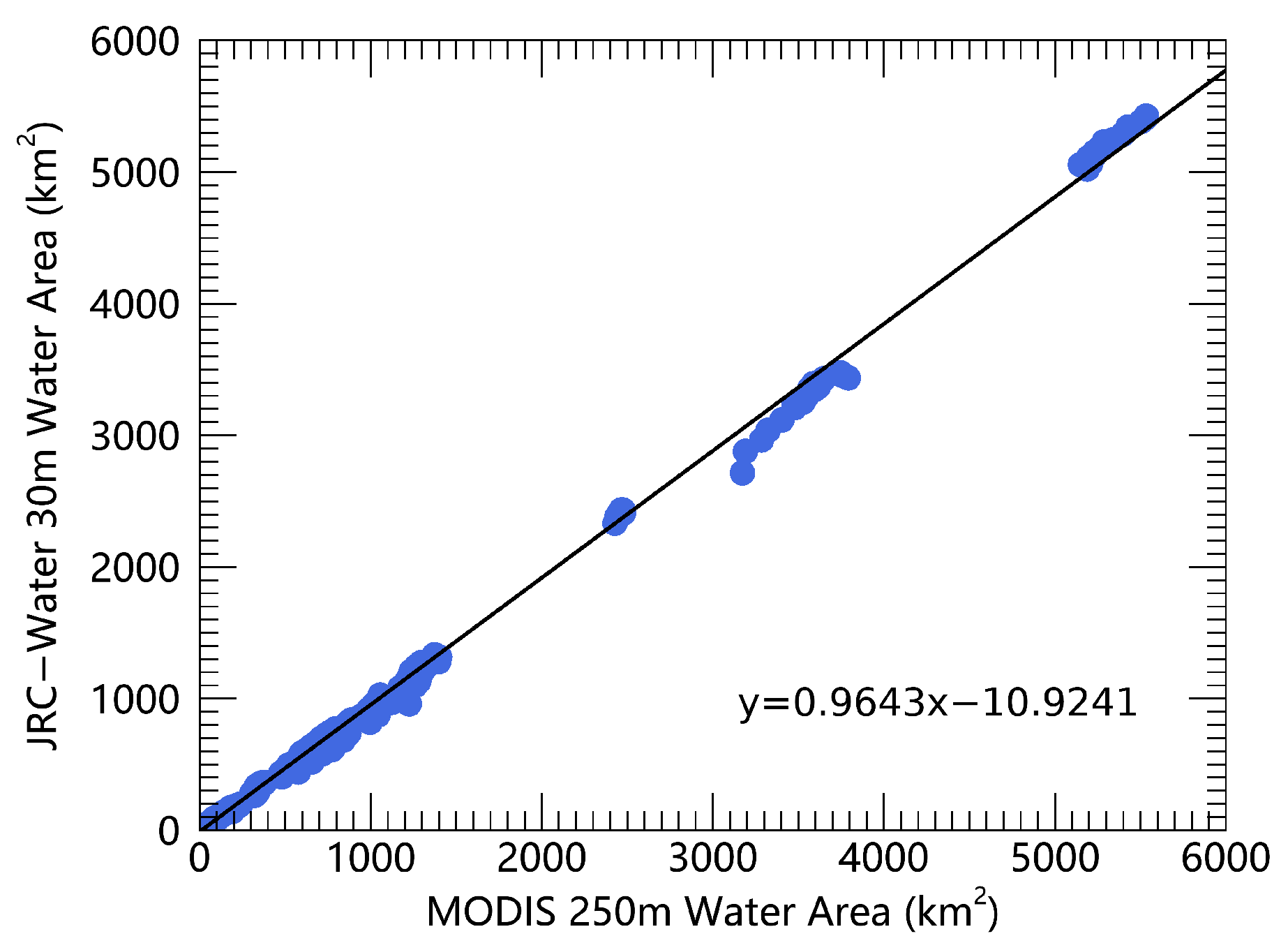


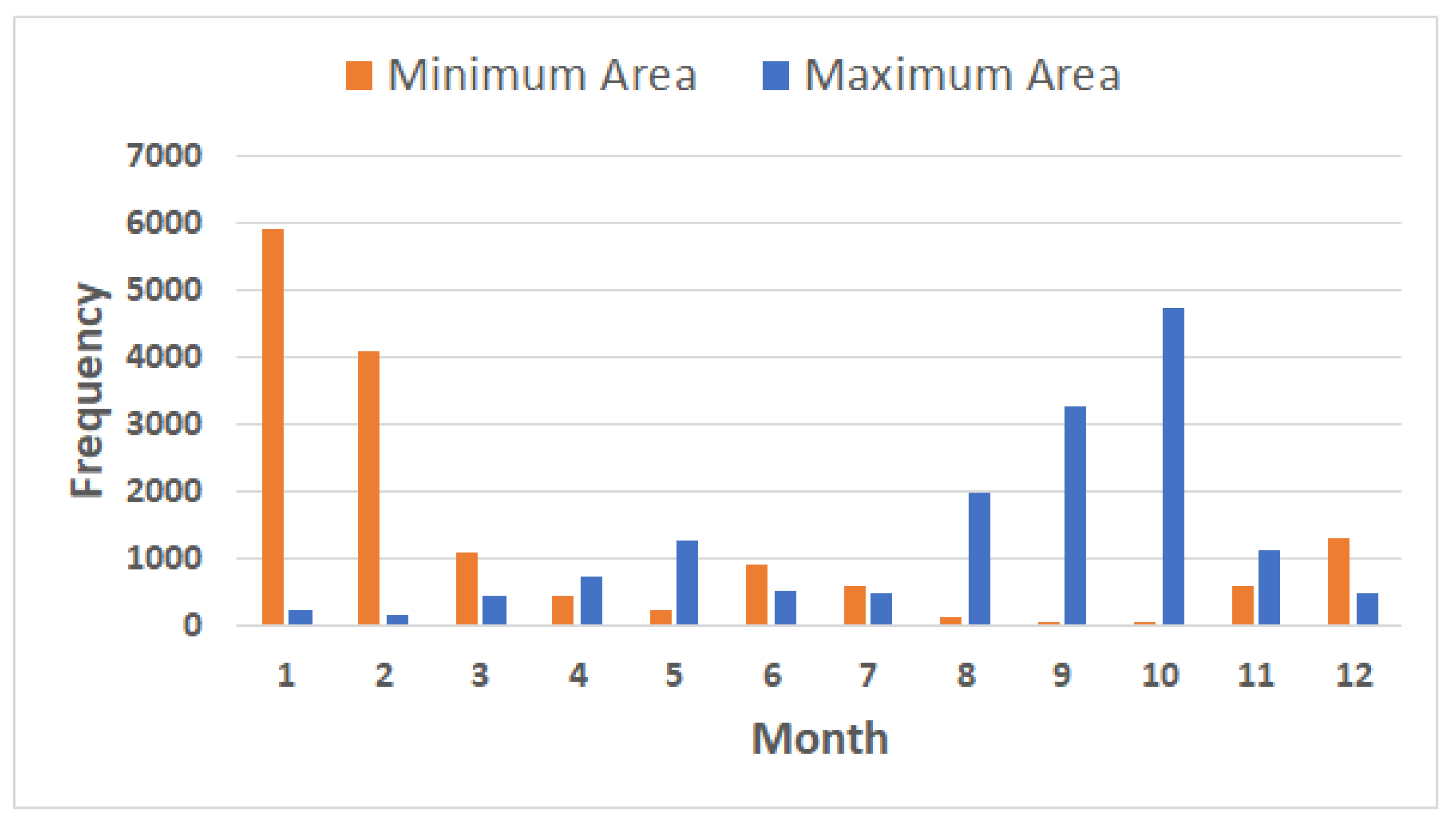


| Data Name | Spatial Resolution (m) | Band Name | Spectral Range (nm) |
|---|---|---|---|
| MOD09GQ | 250 | R | 620–670 |
| MYD09GQ | NIR1 | 841–876 | |
| 500 | B | 459–479 | |
| G | 545–565 | ||
| MOD09GA | R | 620–670 | |
| MYD09GA | NIR1 | 841–876 | |
| NIR2 | 1230–1250 | ||
| SWIR1 | 1628–1652 | ||
| SWIR2 | 2105–2155 |
| Ground Truth | |||||
|---|---|---|---|---|---|
| Classified | Land | Water | Snow/Ice | Precision (%) | |
| Land | 883,705 | 17,036 | 5771 | 97.4841 | |
| Water | 15,925 | 535,928 | 7383 | 95.8322 | |
| Snow/Ice | 794 | 357 | 57,583 | 98.0403 | |
| Recall (%) | 98.1432 | 96.8566 | 81.4044 | 96.8995 | |
| Size | RMSE () | MRE (%) | |
|---|---|---|---|
| ≥2000 | 173.4160 | 3.8687 | 0.996342 |
| 1000∼2000 | 93.6652 | 6.9041 | 0.951405 |
| 500∼1000 | 65.2778 | 6.9961 | 0.945332 |
| ≤ | 13.8417 | 10.2867 | 0.997600 |
| All | 59.5831 | 9.0526 | 0.999258 |
| Changing Rate () | ≤ | ≥0.5 | ||
| Number of Lakes | 12 | 147 | 947 | 187 |
| No. | 2000 | 2005 | 2010 | 2015 | 2020 | 2024 |
|---|---|---|---|---|---|---|
| 1 | Qinghai Lake | Qinghai Lake | Qinghai Lake | Qinghai Lake | Qinghai Lake | Qinghai Lake |
| 2 | Namtso Lake | Selin Co | Selin Co | Selin Co | Selin Co | Selin Co |
| 3 | Selin Co | Namtso Lake | Namtso Lake | Namtso Lake | Namtso Lake | Namtso Lake |
| 4 | Zhari Namco | Zhari Namco | Qarhan Salt Lake | Qarhan Salt Lake | Qarhan Salt Lake | Qarhan Salt Lake |
| 5 | Chibuzhang Co and Dorsodung Co | Chibuzhang Co and Dorsodung Co | Chibuzhang Co and Dorsodung Co | Chibuzhang Co and Dorsodung Co | Chibuzhang Co and Dorsodung Co | Chibuzhang Co and Dorsodung Co |
| 6 | Tangra Yumco | Qarhan Salt Lake | Zhari Namco | Zhari Namco | Zhari Namco | Zhari Namco |
| 7 | Ayakum Lake | Tangra Yumco | Ayakum Lake | Ayakum Lake | Ayakum Lake | Ayakum Lake |
| 8 | Yamdrok Lake | Ayakum Lake | Tangra Yumco | Tangra Yumco | Tangra Yumco | Tangra Yumco |
| 9 | Eling Lake | Yamdrok Lake | East and West Eling Lake | East and West Tazhong Lake | East and West Tazhong Lake | East and West Tazhong Lake |
| 10 | Hala Lake | Eling Lake | Eling Lake | Ulan Ula Lake | Ulan Ula Lake | Ulan Ula Lake |
Disclaimer/Publisher’s Note: The statements, opinions and data contained in all publications are solely those of the individual author(s) and contributor(s) and not of MDPI and/or the editor(s). MDPI and/or the editor(s) disclaim responsibility for any injury to people or property resulting from any ideas, methods, instructions or products referred to in the content. |
© 2025 by the authors. Licensee MDPI, Basel, Switzerland. This article is an open access article distributed under the terms and conditions of the Creative Commons Attribution (CC BY) license (https://creativecommons.org/licenses/by/4.0/).
Share and Cite
Feng, Q.; Yu, K.; Ji, L. Daily Water Mapping and Spatiotemporal Dynamics Analysis over the Tibetan Plateau. Hydrology 2025, 12, 257. https://doi.org/10.3390/hydrology12100257
Feng Q, Yu K, Ji L. Daily Water Mapping and Spatiotemporal Dynamics Analysis over the Tibetan Plateau. Hydrology. 2025; 12(10):257. https://doi.org/10.3390/hydrology12100257
Chicago/Turabian StyleFeng, Qi, Kai Yu, and Luyan Ji. 2025. "Daily Water Mapping and Spatiotemporal Dynamics Analysis over the Tibetan Plateau" Hydrology 12, no. 10: 257. https://doi.org/10.3390/hydrology12100257
APA StyleFeng, Q., Yu, K., & Ji, L. (2025). Daily Water Mapping and Spatiotemporal Dynamics Analysis over the Tibetan Plateau. Hydrology, 12(10), 257. https://doi.org/10.3390/hydrology12100257







